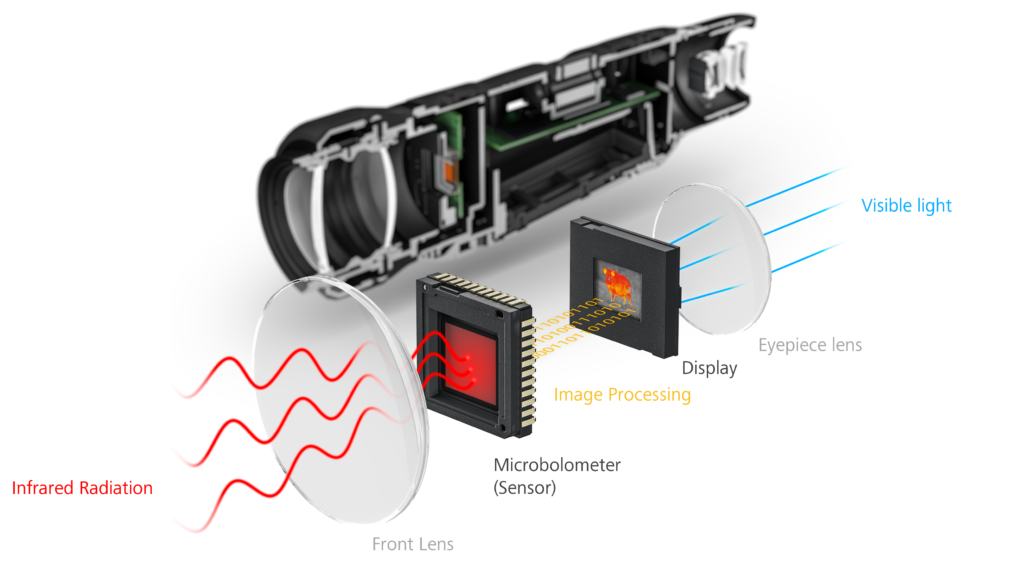An interview on the image formation process in thermal imaging cameras and how the ZEISS DTI 6’s ZSIP Pro sets new standards in detail recognition.
When identifying species, every detail counts. The smallest distinguishing features specific to a species can play a critical role in identifying the animal’s sex and age. When using the new ZEISS DTI 6 thermal imaging camera with the proprietary ZEISS ZSIP Pro image processing algorithm, a new level of detail becomes visible. But how does the image actually make it to the viewer’s eye? And what’s so special about ZSIP Pro? We spoke with our category manager, Tammo Lueken, about exactly these questions to shed light on what is behind the ZSIP Pro.
In order to understand what makes ZSIP Pro so special, we first need to explore how an image is created in a thermal imaging camera. Tammo, can you briefly explain this process to us?
Tammo: “Thermal imaging devices differ greatly from traditional optical devices for observation, such as binoculars. The optoelectronic devices are more comparable to a digital camera – and those who have been familiar with ZEISS for a while know that we’re experts when it comes to cameras and lenses! While the light sensitivity of conventional digital cameras lies in the visible range of the human eye, thermal imaging cameras operate in the long-wave infrared range. A thermal imaging camera detects and measures the infrared energy emitted by objects. This allows them to detect the thermal radiation emitted by a body independent of the available visible light, which is why thermal imaging devices can be used both in daylight and in total darkness.

The image formation process can basically be divided into the following steps: First, an image is projected onto an electronic image sensor through the front lenses in the objective lens, which are made of germanium. The electronic signal coming from the sensor, known as a microbolometer, is then digitized and processed by a complex image processing algorithm. Using this algorithm, the processor then creates a multicolored representation of the object’s temperature based on the signals from the individual pixels. In this process, each temperature value is assigned to a specific color and shown on the display. In this way, the viewer recognizes the captured and processed image through the eyepiece lens.”
This image processing is exactly what we would like to take a closer look at. The new DTI 6 thermal imaging camera is equipped with what ZEISS has dubbed: “ZSIP Pro”. What does ZSIP mean?
Tammo: “ZSIP stands for ZEISS Smart Image Processing and refers to a proprietary image processing algorithm developed by ZEISS that optimizes the thermal images from the sensor in a three-stage process. This produces a particularly detailed and high-contrast image for observers.”
You have been an outdoor enthusiast yourself for almost 15 years and know exactly what is important when observing and what requirements the equipment has to meet. How does ZSIP Pro differ from previous thermal imaging products on the market?

Tammo: „When observing and identifying birds and other wildlife, there are often large temperature differences between the particularly cold sky and the warm animal. Comparable image processing algorithms have so far often been unable to compensate for this, making it difficult to identify the details you are looking for in an almost completely darkened image. Previously, you always had to resort to shifting the camera’s viewing angle and pointing the camera toward the ground to block out the cold sky. This made the image contrasty again, but the observed species was at the edge of the field of view, which is hard on the eyes over a long period of time. With the innovative ZSIP Pro, this is now a thing of the past – the image remains contrasty and detailed despite the large temperature differences.”
How does this work?
Tammo: “The image created by the sensor signal contains a tremendous amount of noise due to the unstable sensor signal, so it can’t be used directly. ZSIP Pro now optimizes this image in a three-step process: In the first step, the sensor output signal is preprocessed to obtain a more stable image and to suppress noise. You can now already make out some structures and heat sources, but the image would still be too low in contrast to make details discernible. To fix this, in the next step the image is divided into several sections for both dynamic and local contrast optimization, and each section is individually optimized with respect to contrast and then adjusted to match each other. The final processing step is an intelligent and adaptive sharpening optimization of the warm image sources to make even the smallest structures and details clearly visible. This now results in a perfectly optimized image in all situations, with sharp contrasts and all of the important details standing out clearly against the dark background. Users now no longer have to constantly shift the image and can relax and look through the center of the frame while easily seeing all the important distinguishing features needed to identify birds and wildlife.”
In addition to ZSIP Pro, what other factors contribute to such a detailed viewing experience with the ZEISS DTI 6?
The device features a 640 x 480 px heat sensor of the latest generation, which already yields more details than a lower resolution sensor, and these details are then passed on to the image processing algorithm.
In addition, the high-resolution 1024 x 768 HD AMOLED display ensures that the ZSIP-optimized images are perfectly displayed to the viewer and, thanks to its ultra-low latency, delivers a smooth viewing experience even during rapid panning movements. The DTI 6’s specially designed eyepiece and extra-wide screen round out the viewing experience. The binocular-like eyepiece is perfectly matched to the screen resolution and offers an immersive viewing experience, even for eyeglass wearers, as the display almost completely fills the field of view.
All in all, ZSIP’s three-stage optimization process consisting of noise reduction, contrast optimization, and image sharpening, as well as the combination of the other features, ensures that viewers can recognize the highest possible level of detail.”